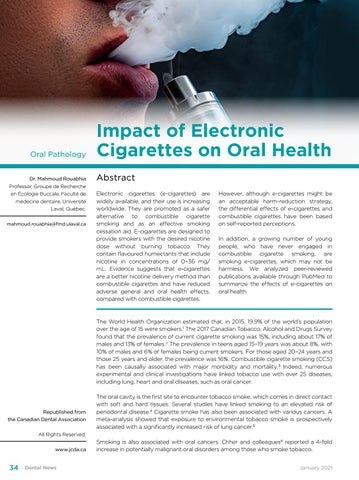Oral Pathology Dr. Mahmoud Rouabhia Professor, Groupe de Recherche en Écologie Buccale, Faculté de médecine dentaire, Université Laval, Québec. mahmoud.rouabhia@fmd.ulaval.ca
Impact of Electronic Cigarettes on Oral Health Abstract Electronic cigarettes (e‑cigarettes) are widely available, and their use is increasing worldwide. They are promoted as a safer alternative to combustible cigarette smoking and as an effective smoking cessation aid. E‑cigarettes are designed to provide smokers with the desired nicotine dose without burning tobacco. They contain flavoured humectants that include nicotine in concentrations of 0–36 mg/ mL. Evidence suggests that e‑cigarettes are a better nicotine delivery method than combustible cigarettes and have reduced adverse general and oral health effects, compared with combustible cigarettes.
However, although e‑cigarettes might be an acceptable harm-reduction strategy, the differential effects of e‑cigarettes and combustible cigarettes have been based on self-reported perceptions. In addition, a growing number of young people, who have never engaged in combustible cigarette smoking, are smoking e‑cigarettes, which may not be harmless. We analyzed peer-reviewed publications available through PubMed to summarize the effects of e‑cigarettes on oral health.
The World Health Organization estimated that, in 2015, 19.9% of the world’s population over the age of 15 were smokers.1 The 2017 Canadian Tobacco, Alcohol and Drugs Survey found that the prevalence of current cigarette smoking was 15%, including about 17% of males and 13% of females.2 The prevalence in teens aged 15–19 years was about 8%, with 10% of males and 6% of females being current smokers. For those aged 20–24 years and those 25 years and older, the prevalence was 16%. Combustible cigarette smoking (CCS) has been causally associated with major morbidity and mortality.3 Indeed, numerous experimental and clinical investigations have linked tobacco use with over 25 diseases, including lung, heart and oral diseases, such as oral cancer.
Republished from the Canadian Dental Association
The oral cavity is the first site to encounter tobacco smoke, which comes in direct contact with soft and hard tissues. Several studies have linked smoking to an elevated risk of periodontal disease.4 Cigarette smoke has also been associated with various cancers. A meta-analysis showed that exposure to environmental tobacco smoke is prospectively associated with a significantly increased risk of lung cancer.5
All Rights Reserved. www.jcda.ca
34
Dental News
Smoking is also associated with oral cancers. Chher and colleagues6 reported a 4-fold increase in potentially malignant oral disorders among those who smoke tobacco. January 2021
